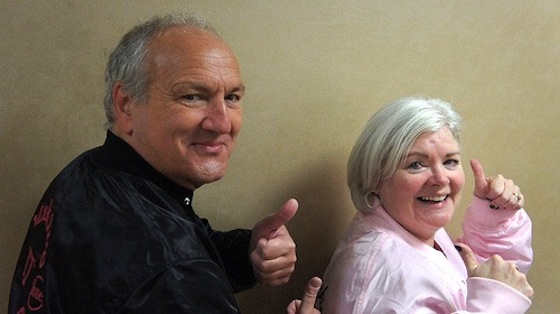
Brenda Sherry and Peter Skillen are leaders in the Powerful Learning Practice community and in the 21st century (that’s NOW) learning communities that hook up to cyberspace in Ontario and other Canadian environs. They’re pictured above, after receiving the ISTE “Making IT Happen” award at ECOO2011. (Creative Commons, aforgrave)
Peter and Brenda, who write here at the Voices from the Learning Revolution blog, are currently leading preparations for PLP Live!, the first public conference to be held by Powerful Learning Practice, set for next Friday (9/28) in Philadelphia. You’re more than welcome to join us!
Brenda and Peter were interviewed this week by Doug Peterson, a well-known Canadian advocate of digitally infused teaching and learning and one of the organizers of ECOO 12, Ontario’s annual gathering of connected educators. We thought we’d share some illuminating excerpts from their talk.
__________
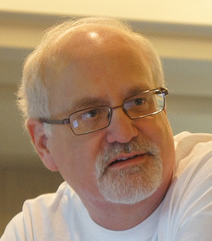 Doug Peterson: Recently, I had the opportunity to interview Brenda Sherry and Peter Skillen, two of the top constructivist advocates in Ontario Education. We discussed ECOO, directions in education and their original professional learning model, Minds on Media. They’re regular participants on Twitter (@peterskillen, @brendasherry) and also blog at The Learning Zone (Brenda) and The Construction Zone (Peter). I’ve worked with both of these wonderful people in recent years in a number of different contexts.
Doug Peterson: Recently, I had the opportunity to interview Brenda Sherry and Peter Skillen, two of the top constructivist advocates in Ontario Education. We discussed ECOO, directions in education and their original professional learning model, Minds on Media. They’re regular participants on Twitter (@peterskillen, @brendasherry) and also blog at The Learning Zone (Brenda) and The Construction Zone (Peter). I’ve worked with both of these wonderful people in recent years in a number of different contexts.
Doug: Thank you, Brenda and Peter, for the opportunity to dig into your thoughts about technology and how best to use it in education.
In reading both your blogs over the years, I know that you mention great thinkers that have influenced your own thoughts. If I had to ask you to narrow it to just one, who would it be and why?
Brenda: Oh boy. This is a difficult question for me because so many thinkers do influence me, including Peter who has been such a great colleague and who pushes my thinking. I’d have to say Seymour Papert and his concept of ‘constructiONism’ has definitely influenced my beliefs about how technology can best support learning in socio-constructivist environments. His views about the value of computational thinking led me to begin programming using MicroWorlds JR in my Grade 1/2 class, and I think this continues to be an overlooked area in educational technology, especially with the recent allure of web 2.0 tools.
Peter: One?! Oh Doug. You’re killing me! Marlene Scardamalia & Carl Bereiter (as a team) would have to rise to the top of my list. Their early (and continuing) work on ‘knowledge construction’ and ‘expertise’ has been instrumental in how I frame much of my learning, reading and everyday work. Back in the eighties, when people spoke of collaborative construction of knowledge they were seen as a bit loony and the term ‘knowledge co-construction’ was viewed as ‘hoity toity’. Now these concepts are de rigueur — everyone is using them. And with that comes the danger of ‘lexical drift’ where they really lose their original meaning.
I would also be remiss if I didn’t acknowledge Brenda for her role in ‘keeping me real’ and in her brilliance in operationalizing much that she and I think and talk about.
Rethinking the ed tech conference
Doug: A few years ago, the two of you were instrumental in rethinking what the ECOO (Educational Computing Organization of Ontario) conference might be. In fact, Brenda chaired the conference for a few years. In what direction do you feel you took the conference?
Brenda: We were definitely observing Ontario teachers beginning to synthesize their knowledge of how people learn in the 21st century and the technologies that really leverage deeper learning. We wanted to share that capacity in a conference for teachers, by teachers. Our mission has been to inspire people with engaging speakers, to connect them through social media, and to focus on teachers as learners – regardless of their expertise with technology – and therefore we’ve called the conference Inspire. Connect. Learn. for several years now. Those three words really guide our planning.
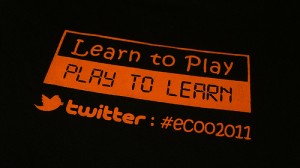 Peter: We wanted to move the conference from a focus on technology to a focus on ‘learning’ and ‘teaching’ enhanced by technologies that have infused the lives of kids, teachers and society at large. It is no longer enough to speak about ‘computers in education’ because, as we know, chips are integrated into so many devices and travel in our pockets. Wearable computers are on the horizon. So it is really important for us to think about these things as ‘cognitive partners’ and to also help educators understand that and the ‘other than cognitive’ impacts – the social restructuring of classroom and schools, media literacy, information, attention and mindfulness issues, etc.
Peter: We wanted to move the conference from a focus on technology to a focus on ‘learning’ and ‘teaching’ enhanced by technologies that have infused the lives of kids, teachers and society at large. It is no longer enough to speak about ‘computers in education’ because, as we know, chips are integrated into so many devices and travel in our pockets. Wearable computers are on the horizon. So it is really important for us to think about these things as ‘cognitive partners’ and to also help educators understand that and the ‘other than cognitive’ impacts – the social restructuring of classroom and schools, media literacy, information, attention and mindfulness issues, etc.
Brenda: Read The Power of Pull by John Seely Brown and his colleagues, for more ideas on transforming organizations. He’ll be keynoting ECOO12 this year.
Doug: In both your roles now, you see and support educators on a daily basis. Could you describe how you fill your days doing this?
Brenda: I’m a technology coach K-12 so I work with teachers who are new to using technology in their classrooms or who have students bringing in their own technology to class (sometimes assistive technology as well). My work involves helping teachers to begin with their learning goals and then choose technology that will support those goals and work well with the kinds of learners they have and their particular subject area. I’m hoping to get some teachers connected within our board for discussion, action research and a celebration of effective technology use this year.
Peter: Most of my work with educators these days is in online spaces – sometimes formally through the Powerful Learning Practice and Ontario Teachers’ Federation and sometimes informally through social networks. In both cases, I am learning to use ‘appreciative inquiry’ to draw out of the individuals what they want to learn and how they want to learn it. Then, it’s my role to help them learn that. At the same time, I have my own larger educational goals in mind – so it is always a balancing act satisfying both our goals.
Teachers who make the Shift
Doug: I’ll put you on the spot. Who is needier? Brand new teachers or educators with some experience?
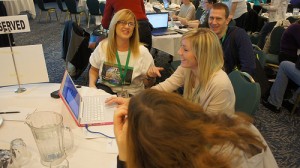 Brenda: Tricky question all right! It’s been my experience that regardless of whether they are new or experienced, teachers who are familiar with cooperative learning or other more student-directed learning environments seem to embrace technology quickly. They see it as a way to get students collaborating, inviting in experts and unique resources, documenting their learning, and making thinking and discussion visible.
Brenda: Tricky question all right! It’s been my experience that regardless of whether they are new or experienced, teachers who are familiar with cooperative learning or other more student-directed learning environments seem to embrace technology quickly. They see it as a way to get students collaborating, inviting in experts and unique resources, documenting their learning, and making thinking and discussion visible.
Teachers who are unfamiliar with the shift that is happening towards learning communities where the teacher is there to ‘facilitate’ learning (and learn along with students) rather than to be the transmitter of knowledge, really need more support. To me, that’s not a question of technology knowledge, as much as a question about what makes 21st century pedagogy different — what needs to change. Both brand new teachers and experienced teachers need to have lots of discussion about this.
Peter: One of the enduring ‘myths’ about change that Brenda and I talk about is this one: “When young teachers join the profession, computers will be integrated effectively.” The assumption is that they are ‘digital natives’ and so are awesome with technology. Well, there are a couple of points to note. One is they may be great with ‘socializing’ with computers a la Facebook or Instagram – but they do not likely have tons of skills related to using computers for cognitive gain or for computational reasons – like programming.
The other point to note is that, as mentioned, it is not all about the technology. It is about a philosophy of learning and teaching. It is about how one perceives the world and how one situates oneself. Who is in charge of the learning?
If you say, ‘students should be in charge of their learning’, then what do you mean by that? It needs to be unpacked and discussed. It requires that you look at scenarios and where power is located. For example, if students are to be in charge of their own learning can they choose not to do assignments or show up for class on time, and so on? Big questions of authority and self-determination.
PLP and 21st century learning theories
Doug: In the past year, both of you have become involved with the Powerful Learning Practice organization. PLP really promotes the concepts of connectivism. Do you find the principles consistent with your core beliefs?
Brenda: Yes! Connectivism is at the heart of the way I do business these days, and PLP does promote that. When I’m asked to coach in a school, for example, it’s not really just me who visits but my whole network, as these are the resources (people and ideas) that I rely upon in order to maneuver effectively through the learning landscape of today’s world.
One of my favourite quotes is by John Holt: “Learning is not the product of teaching. Learning is the product of the activity of learners.” I do believe that learning in groups can result in a synergy not present in individual settings — that learning is social and that activity with others is a key part of building knowledge. Along with that comes a necessary balance of individual reflection….but that’s a whole new discussion!
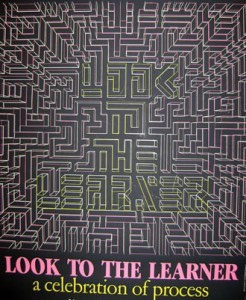 Peter: I agree that Powerful Learning Practice (PLP) promotes the concepts of connectivism. But I also see that PLP blends a huge number of current and long-standing theories and practices, including connectivism, into its work with professional learners. This potpourri is extremely consistent with my beliefs. And, to be truthful, those who know me recognize that I would not be involved with an organization so deeply if that were not the case. (Smile)
Peter: I agree that Powerful Learning Practice (PLP) promotes the concepts of connectivism. But I also see that PLP blends a huge number of current and long-standing theories and practices, including connectivism, into its work with professional learners. This potpourri is extremely consistent with my beliefs. And, to be truthful, those who know me recognize that I would not be involved with an organization so deeply if that were not the case. (Smile)
Now, do I agree with every detail of these theories? Clearly not. But that is the nature of being a critical thinker, isn’t it? Finding dissonance in practice or theory is what leads to advancing new ideas and changing it up. There is no truth. There are only approximations. Maybe we are all TAs – Theory Approximators! LOL
Doug: So, connectivism and constructivism can co-exist?
Brenda: In my mind, yes, they can co-exist. Since I’m a believer in Papert’s ‘constructionism’ (the act of creating artifacts that demonstrate knowledge), connectivism is a nice complement because it suggests that once knowledge has been articulated in some form (i.e. made public in some way — it’s made its way out of your head, so to speak) then the ability to connect can enhance that knowledge either by building upon it, reflecting upon it, or through the discourse that might arise from it. I admit I did try to attend the MOOC that George Siemens and Stephen Downes have facilitated on Connectivism, but I’m afraid that I need to make more time for it and try again to get a better handle on the theory.
Peter: In my mind, they absolutely can co-exist. But, then I think constructivism and behaviourism can co-exist. And that would be a stretch for most people. (Smiles) But, here’s my recent thinking on that one.
Most of our day to day activities are carried out by each of us without conscious thought or even awareness — certainly not by an overt decision-making process. We couldn’t possibly manage to get through the day if that were the case. Can you imagine the turmoil a centipede would have if she tried to think and decide which leg should be moved at which time? She’d be tripping and falling all day long! So we run on auto-pilot. And, yes, of course we also make many decisions based on weighing alternatives. I get that. But, when one acknowledges the premise, then one is agreeing that automatized, behaviourist responses are integral to our everyday living.
Yet, on a different level, we are conscious, decision-making creatures with a soul, a heart, and a sense of self. So we can exercise our metacognitive skills in setting goals, generating alternative strategies and reflecting on our learning. Our minds, in this western society, tend to lean towards distinct categorization of the world around. It is the way we attempt to make sense of it. I understand that. It also leads us to parse the world in dichotomies – an ‘on’ or ‘off’, a ‘yes’ or ‘no’, kind of categorization. This, of course, has been amplified by our binary age of ‘ones’ and ‘zeroes’.
However, it is not necessary to think that my philosophy of education is ‘constructivist or not’ or ‘connectivist or not’. The world is much more complex than that. It is a rich fabric of textured confusion which has many elements interwoven throughout – so I believe that there are elements of many theories that make up my educational philosophy. If you want to hear more about this (smile), read my post “I’m Confused! I Thought I was a Social Constructionist!”
The Minds on Media learning experience
Doug: The Minds on Media is a unique professional learning experience. I have been “brought into the fold” and have served both as a facilitator and a pedagogista. How did you develop the concept?
Brenda: After many years of participating in professional development, both as learners and facilitators, we started to talk about the fact that the dominant method of professional learning (usually ‘sit and git’ — not entirely responsive to the needs of the learners) didn’t always match the kinds of shifts in practice that need to happen in a technology infused classroom.
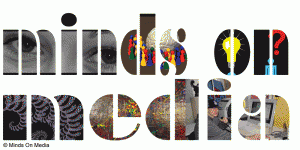 We thought that by experiencing an alternative that is learner driven, multi-modal, and somewhat ‘flipped’ to give the learner control over resources and activities that fit their needs, teachers would better grasp how such a model might look in the classroom. We are NOT saying that a lecture-style presentation isn’t excellent in certain cases and serves a purpose for learning that we all need and enjoy at one time or another, Rather, we are saying that there are alternatives and engaging teachers in this kind of learning themselves is a good place to start.
We thought that by experiencing an alternative that is learner driven, multi-modal, and somewhat ‘flipped’ to give the learner control over resources and activities that fit their needs, teachers would better grasp how such a model might look in the classroom. We are NOT saying that a lecture-style presentation isn’t excellent in certain cases and serves a purpose for learning that we all need and enjoy at one time or another, Rather, we are saying that there are alternatives and engaging teachers in this kind of learning themselves is a good place to start.
Peter: The concept grew somewhat organically – except to say that we both have strong beliefs about several learning principles:
- the locus of control for learning should be in the hands of the learner
- the facilitator must be aware of, and respond to, the learner’s desires, needs and expertise
- the learner should leave the experience empowered to learn further – beyond the Minds on Media event
- there are always experts among us
So it made a lot of sense when we were organizing the ECOO conferences that we run a ‘hands on’ day for people with these ideas in mind. But, we wanted more than their hands on – we wanted their ‘minds on’.
How Pedagogistas help teachers learn more
Doug: Explain the role of the pedagogista for my readers please.
Brenda: I’ve always been interested in constructivist approaches, and a few years back Gary Stager recommended a book called The Hundred Languages of Children which outlines the Reggio Emilia approach for early childhood education that began in Italy.
One of the elements that stood out most for me was the emphasis that the schools put on teacher observation and reflection in understanding their learners. They value this so much, in fact, that “pedagogistas” work alongside teachers to keep the focus on pedagogy and to use observations to direct next steps with students. It’s really a constantly evolving kind of formative assessment. It’s easy when teaching to be caught up in the tasks of the moment related to lessons or the plan for the day. The pedagogistas bring a more metacognitive approach to the classroom. They help teachers keep that window open. We thought it would be valuable to have that role during Minds On Media as well!
Peter: I know Brenda will answer this one more ‘correctly’ than I because of her greater familiarity with its roots. I take some liberty with the construct of ‘pedagogista’. (Smile) For Minds on Media, we felt it necessary to have one or two folks roaming around the space, listening in, being attuned for opportunities to be the ‘metacognitive’ prompter!
You know, when you are engrossed in learning a skill, it is sometimes difficult to ‘zoom out’ and to see the bigger picture. The pedagogista can assist in that ‘envisioning’ – that shifting of the lens so that the learner (teacher) can see their learning in a larger context.
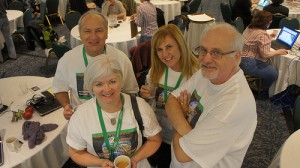
A Pedagogista Squad
So in our Minds on Media model, with participants moving among various centres or learning stations, the pedagogista might say: “I see you are here at this centre asking questions that you have about this topic. How’s that working for you compared to a sit ‘n’ git session? I’m wondering how you might see that occurring in your classroom.” Or, “You are doing interesting things with Google docs at this centre. Can you imagine ways this might enhance your students’ learning?”
Doug: From my experience, you have taken a very liberal approach to the word “Media”! What does “Media” mean to you in “Minds on Media”?
Peter: Media, to me, are any artifacts of thought that are externalized. So written words, spoken words, typed words, paintings, sounds produced, and so on qualify as media as do the tools that produce them. Pretty liberal in some senses – but quite classic as well.
Brenda: To me, media can mean tools and techniques as well as the activity of constructing messages. We vary the kinds of centres we have at Minds on Media; sometimes we are exploring ways to construct artefacts using technology (e.g., Scratch, logo, digital storytelling), sometimes we are exploring the use of tools to develop a different kind of community of learners (e.g., Edmodo, blogging, wikis, PLNs). You’re right, we do use the term loosely, often based upon the passion of those who might be running a centre.
I think we put more emphasis on the fact that we’d like people to play with media ‘mindfully’ – to be reflective, purposeful and playful in their approach to using media in the classroom.
Doug: The next opportunity that educators have to experience a Minds on Media event will be a pre-conference for the ECOO conference. What sorts of things would a participant experience?
Brenda: It’s going to be a treat! Our theme is knowledge building so facilitators took that in a way that speaks to them, and we have the following centres this year:
- Documenting Student Achievement with Aviva Dunsiger
- Using iPads for Knowledge Construction in the Learner-Centered Classroom with Colin Harris
- The Idea Hive Classroom Community: Students Sharing, Creating and Learning Together in Online Spaces with Heather Durnin
- Social Networking with Edmodo with Peter McAsh
- Making Thinking Transparent and Visible with Voicethread with Royan Lee
- Discover how to Create an Inclusive Classroom by Infusing Powerful Equity Messages
- Throughout your Day with Susan Watt and Trish Morgan
- Using Audio in the K-12 Classroom with Zoe Branigan-Pipe
- Special Education and Technology with Kim Gill
- Thinking and Creating with Melinda Kolk – Owner, Tech4Learning
Peter: Brenda has named the centres we have this year so that is the tangible side. People will experience dissonance, control, frustration, deep learning, exhilaration and a sense of belonging to a community of like-minded educators.
[Editor: Brenda and Peter are also helping with the PLP Live conference in Philadelphia on September 28th, and there will be a “Minds on Media-like” event, featuring what PLP leader Sheryl Nussbaum Beach is calling Shift Sessions.]
Trying the Minds on Media model in your PD
Doug: I’m a real supporter of this model for professional learning. Do you have a formula that a school district or other organization could use to facilitate a session of their own?
Brenda: Well, it’s about honouring the expertise that already resides in your district, so we encourage folks to create their own sessions and celebrate their own educators. We do feel that there are some critical elements to making the day work well, and we share some of these at this site: Minds on Media. Like most good learning environments, much of the preparation goes on in the background and before the day arrives. We hope that anyone who values the approach can feel free to take what we’ve learned and try it out with their own spin to it!
Peter: As Brenda says, we are interested in helping people understand what has made it work and discussing how it can be better. Take the resources and thoughts and fly!
John Norton
Latest posts by John Norton (see all)
- I'm a "Learner First" in a Whole New World - July 1, 2013
- Hale@home: Easing Student Transitions via Online Learning - May 17, 2013
- Our Top 13 Voices Posts for 2012! - January 1, 2013

